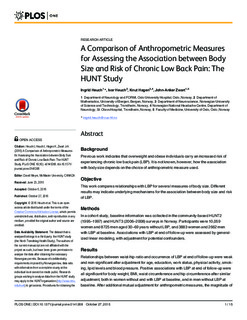| dc.description.abstract | Background:
Previous work indicates that overweight and obese individuals carry an increased risk of experiencing chronic low back pain (LBP). It is not known, however, how the association with body size depends on the choice of anthropometric measure used.
Objective:
This work compares relationships with LBP for several measures of body size. Different results may indicate underlying mechanisms for the association between body size and risk of LBP.
Methods:
In a cohort study, baseline information was collected in the community-based HUNT2 (1995–1997) and HUNT3 (2006–2008) surveys in Norway. Participants were 10,059 women and 8725 men aged 30–69 years without LBP, and 3883 women and 2662 men with LBP at baseline. Associations with LBP at end of follow-up were assessed by generalized linear modeling, with adjustment for potential confounders.
Results:
Relationships between waist-hip-ratio and occurrence of LBP at end of follow-up were weak and non-significant after adjustment for age, education, work status, physical activity, smoking, lipid levels and blood pressure. Positive associations with LBP at end of follow-up were all significant for body weight, BMI, waist circumference and hip circumference after similar adjustment, both in women without and with LBP at baseline, and in men without LBP at baseline. After additional mutual adjustment for anthropometric measures, the magnitude of the association with body weight increased in women without LBP at baseline (RR: 1.130 per standard deviation, 95% CI: 0.995–1.284) and in men (RR: 1.124, 95% CI 0.976–1.294), with other measures showing weak associations only.
Conclusion:
Central adiposity is unlikely to play a major role in the etiology of LBP. Total fat mass may be one common factor underlying the associations observed. The association with body weight remaining after mutual adjustment may reflect mechanical or structural components behind the relationship between overweight or obesity and LBP. | nb_NO |
